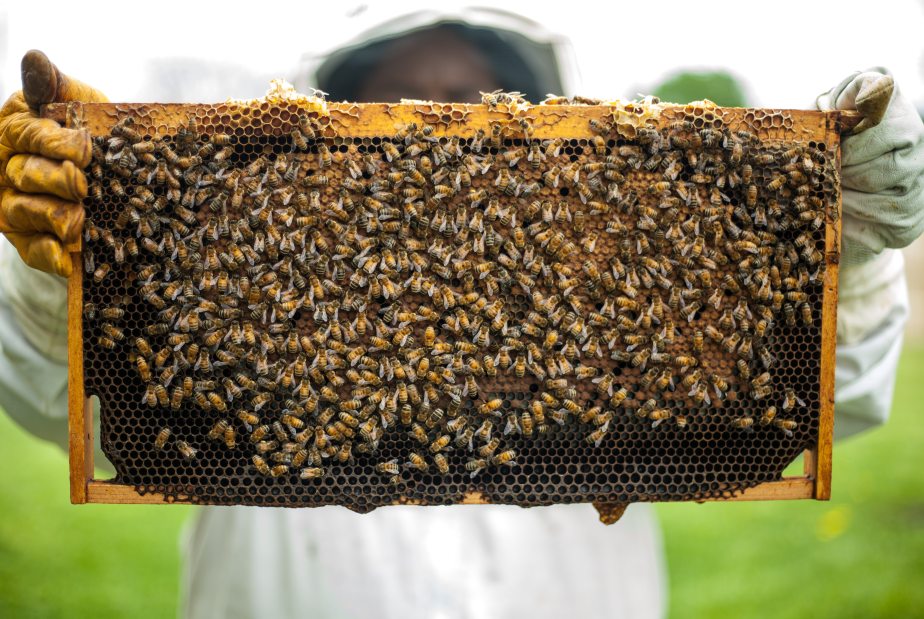Besides being annoyed with, or eating them perhaps our longest and most important relationship with insects has been with their use in medicine. Ancient cultures from all over the world have used insects for numerous medical reasons.
Here in Australia Aboriginals used Green Tree Ants as a remedy for headaches and colds by crushing them up and making a tea-like beverage. Across South America and Africa, indigenous tribes used Army Ants as a way to stitch up wounds by allowing the ants to bite on the open wound, pinching it together, the body was then ripped off leaving the head and pinchers in the skin (Survival Goods, 2019). In ancient Asian cultures, Blister beetles were used as an early treatment for erectile dysfunction, but in more recent times their fluids have been diluted to be used as relief from burning sensations caused by insect bites, first and second-degree burns and even urinary tract infections (Turk, 2012).
As time has progressed the use of insects for medicinal purposes has only increased in effectiveness for a multitude of illnesses and injuries. Bees, for example, have been proven to be extremely useful. Right from their honey – which can be used in chapsticks and lotions and when consumed locally, it can be used to help with allergies – to their venom which can be used as an anti-inflammatory and as pain relief.
Even the peskiest of pests have incredible abilities in the medical world. That’s right, I’m talking about flies and mosquitos. Blowflies, in particular, their lifecycle, are used by forensic scientists to accurately tell how a body has been decomposing which gives them the time of death. Furthermore, common housefly larvae extracts can be used in antibiotics for the treatment of fungus infections. Mosquitos, although notoriously known for spreading diseases have been deemed useful in some situations. Although it’s not the most common, or effective way to treat syphilis, malaria-infected mosquitos are used to infect patients with malaria which in turn eats away at the syphilis infection, of course, the patient will then have to be treated for malaria once they have been cured of their STI.
The list for past and present uses for hundreds of different species of insects goes on and on, but how might insects be of further use to doctors and researchers in the future?
Let’s go back to bees and their relatives the wasp. Bee and wasp venom is already being studied for it’s potential as a cure for cancer. In fact, wasp venom has been successfully used to eradicate certain cancer cells while leaving healthy ones alone. “The cancer-targeting toxin in the wasp is called MP1 (Polybia-MP1) and until now, how it selectively eliminates cancer cells was unknown. According to new research, it exploits the atypical arrangement of fats, or lipids, in cancer cell membranes” (IFLScience, n.d.). While it has been successful, there is much more research that must be conducted before it is a viable option for people. Bee venom has been named as a potential cure for HIV as it attacks the unhealthy cells in the same way that wasp venom does to cancer (Nordqvist, 2013).
Another possible use for insects that scientists have identified is the ‘use of bugs to cure superbugs’. You might be familiar with the fact that our bodies build up a resistance to antibiotics thus causing the strain to mutate in a way that makes our current antibiotics useless. The term “peak pharma” gets passed around in the medical community eluding the notion that a whole bunch of curable diseases and illnesses are about to get a whole new lease on life, and we might not be ready. An example of a super strain that is already starting to mutate and become harder to treat is gonorrhea, but even ailments like depression and cancers will get a new lease of life. But according to Ross Piper, an entomologist, and researcher at the University of Leeds, there is a huge amount of untapped potential in insects just waiting to be discovered to cure these diseases and illnesses (Farah, 2018).
Both in short and long-term time periods, the use of insects in medicine will continue to be an extremely challenging but rewarding process. Goals in both time frames will rely heavily on research and funding. Entomologists, doctors, scientists, and researchers will have a big job ahead of them in refining the uses for insects that have previously been identified as viable, and in identifying new insects that can be used. Another goal for the industry is to be able to take the DNA sequence in certain insects that are working and then replicating it synthetically in a lab to be used in mass quantities.
So the next time you see a creepy crawly in your house or have an annoying fly buzzing around your ear try to remember that they might just be the very thing to save your life!
References:
Survival-goods.com. (2019). 15 Insects You Can Use To Cure Wounds And Diseases. [online] Available at: https://www.survival-goods.com/15-Insects-You-Can-Use-To-Cure-Wounds-And-Diseases-s/500.htm
Turk, A. (2012). 10 Surprising Uses of Insects in Medicine. [online] Nursing School Rankings. Available at: http://www.nursing-school-rankings.com/10-surprising-uses-of-insects-in-medicine/
Lupo, L. (2019). Using Insects as Medical Cures – Past and Present. [online] The Spruce. Available at: https://www.thespruce.com/medical-insects-that-heal-2656717
IFLScience. (n.d.). Brazilian Wasp Venom Kills Cancer Cells, But Not Healthy Cells. [online] Available at: https://www.iflscience.com/health-and-medicine/brazilian-wasp-venom-kills-cancer-cells-not-healthy-cells/
Nordqvist, C. (2013). Bee Venom Destroys HIV And Spares Surrounding Cells. Medical News Today. [online] Available at: https://www.medicalnewstoday.com/articles/257437.php
Farah, T. (2018). Drugs from Bugs: Bioprospecting Insects to Fight Superbugs. Discover Magazine: Science for the curious. [online] Available at: http://blogs.discovermagazine.com/crux/2018/04/13/drugs-insects-antibiotics-superbugs/#.XPo2AdMzbOQ
Ratcliffe, N., Azambuja, P. and Mello, C. (2014). Recent Advances in Developing Insect Natural Products as Potential Modern Day Medicines. Evidence-Based Complementary and Alternative Medicine, [online] 2014, pp.1-21. Available at: https://www.hindawi.com/journals/ecam/2014/904958/.




One thought on “Bee-cause that pesky insect might just save your life one day. D.A. Part 3”